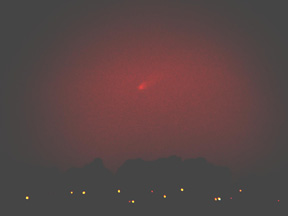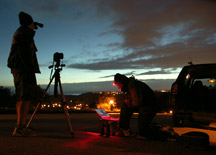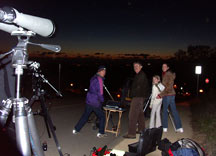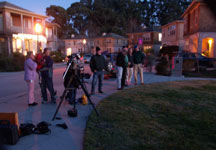Comet McNaught (C2006/P1) - Jan 8-20, 2007
This comet turned out to be much
brighter than originally expected - brighter than Hale-Bopp, and the brightest
comet since Ikeya-Seki in 1965. I admit it kind of took me by suprise. My first
look at the comet came after I called Allen G and we agreed to meet out front
of his home in the hills of Aptos with a clear view of the ocean horizon. The
comet came into the evening sky on Jan. 8 and promised a few nights setting
late enough in twilight that it would be visible and photograph-able. I spotted
it in the 10x70 binoculars soon after sunset, guessing it's magnitude to be
-1.5 by comparing to Venus. The tail was immediately visible as a bright, short
fan shape. Allen set up his Televue scope and had an adapter to mate his shirt-pocket
Nikon digital, and got some nice images. We were very lucky to have perfect
weather - clean skies, warm, high pressure, and no wind. And not a cloud in
the sky.
Jan 8 - At Allen Ginzburg's
Home
|
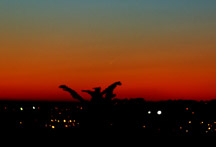
My best
photo of this night; Dimage A2. Photoshop CS2: levels, cropped. |
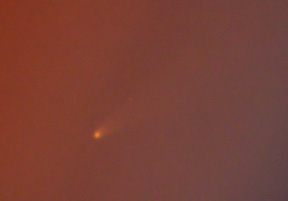
Allen's picture;
I post-processed in Photoshop CS2 by rotating the comet to proper orientation,
and doing 2 passes using Astro Tools 'space noise reduction', and applying
levels
|
|
|
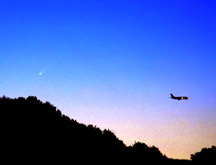
Chris
Kitting snapped this nice shot of aerial travellers going their separate
ways on this same night, from his backyard in the Hayward Hills. Nikon
80-400mm zoom on tripod. |
Jan 9 - Off Western Drive
More perfect weather tonight. This
night I drove up Western Drive on the extreme west side of town and found a
spot with a perfect horizon, with the sun setting over a ridge a half mile away
with some photogenic trees to frame the images. A nice added suprise was to
find UCSC astronomer Stephen Thorsett walking by with his young daughter, and
they enjoyed the comet show with me. All pictures are through the Megrez 80mm
f/6 APO refractor with the ST2000XCM at T=-20C and with the GM8 mount only approximately
polar aligned, with no self-guiding. Not necessary - the exposure lengths are
all 1 second or less! Altitudes below are unrefracted, using time and ECU software.
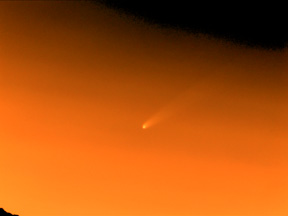
0.3
second exposure, single-shot color processed with DDP option in CCDOPS5,
then in Photoshop CS2: levels, AstroTools 'space noise reduction', color
balance. Comet altitude is 1° 05', and the sun is -7.5°. |
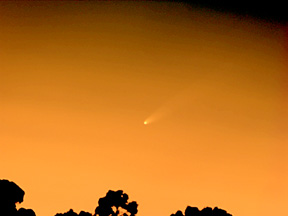
0.6
second exposure, single-shot color processed with DDP option in CCDOPS5,
then in Photoshop CS2: AstroTools 'space noise reduction', unsharp mask,
color balance. In the heat of battle, this one was under-exposed. Note
the image is all in the lowest of the 8-bit levels. Comet altitude is
0° 55', and the sun is -7.7°. |
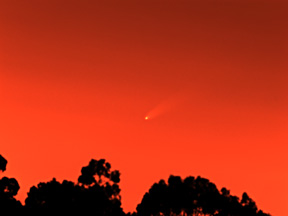
0.8
second exposure, single-shot color processed with RGB option in CCDOPS5,
then Photoshop CS2: unsharp mask, color balance, brightness/contrast.
Comet altitude is 0° 48', and the sun is -7.8°. |
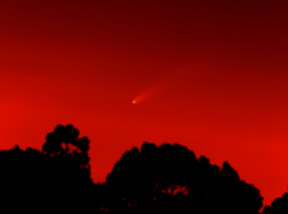
0.8
second exposure, single shot color processed with RGB option in CCDOPS5,
then Photoshop CS2: levels, cropped, curves, brightness/contrast, AstroTools:
2x 'space noise reduction'. Comet altitude is 0° 40', and
the sun is -8.0°. |
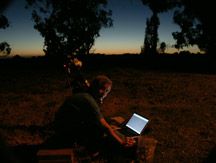
At the
laptop, in fading twilight |
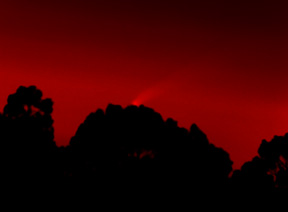
1 second
exposure, single-shot color processed with DDP option in CCDOPS5, then
in Photoshop CS2: smart sharpen, AstroTools 2x 'space noise reduction',
levels, crop. Comet altitude is 0° 30', and the sun is -8.2° |
Jan 10 - At Cabrillo College
on Horticulture Hill
Jonathan Crockett and I met and did
find the comet on this cloudy, cold, and windy evening. But, it only stayed
above the clouds long enough to tempt us to scramble and set up our gear, only
to have it disappear behind the advancing front. Got one nice hero shot, and
that's it.
Jan 11 - At Cabrillo College
on Horticulture Hill
This time, we were joined by Chris
Angelos, and also a mother and young daughter who stayed after a nice sunset
to see the comet. It been almost doubling its brightness every other night...
I estimate magnitude -3 this night, and the brilliant nucleus and fan tail were
visible easily as soon as the sun hit the horizon, even though the comet was
only 7 degrees above the sun and very deep in twilight. In fact, I had a hard
time photographing it because the twilight was so bright it saturated the CCD
camera even at the smallest exposure times, until relatively late in the show.
And even then, the brilliant nucleus and very brief window of opportunity, led
to underexposure on the tail due to the inability of the camera to show a raw
image properly scaled. Jonathan took shots through his Megrez with his digital
camera and will hopefully send me his best. Below, all are with the Megrez 80mm
APO refractor, ST2000XCM with chip T=-20C. All are dark subtracted and flatfielded.
My choice was to bring out the tail as much as possible, and different single-shot
color processing was required for each exposure. The colors were a big problem
on the early shots. Perhaps because the detector spent a fair amount of time
overexposed before beginning shooting. Bad columns are also evident. All exposures
needed photoshop 'clone stamp' tooling to remove blooming on the nucleus' pixel
column. A very bright comet in very bright twilight - extreme conditions.

5:34:00pm. Exposure
0.02sec. sRGB+gamma in CCDOPS5. The nucleus was so bright it bloomed
over the 16 bit limit. The short exposure led to grainy sky background
and poor color rendition. Comet altitude is 2 56', sun is -4 28'.
|
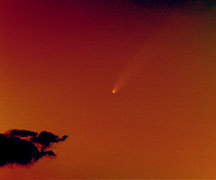
5:36:54pm. Exposure
0.02sec. Comet alt = 2 24', sun -5 01'. sRGB+gamma in CCDOPS5.
|
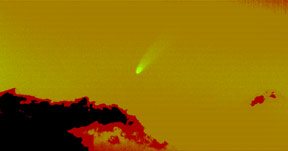
5:39:00pm. Exposure
0.10sec. Comet alt = 2 03'. sRGB color processing in CCDOPS. The color
was just impossible to fix, so I made this into a more artsy picture.
|
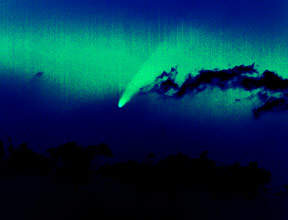
5:40:22pm,
exposure 0.10sec. DDP single-shot color in CCDOPS. Photoshop - Heavy color
alterations and processing to bring out the comet tail. Couldn't get the
colors to look realistic. But it's got a great moody look so who cares
about realism? |
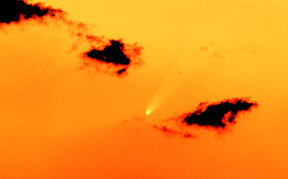
5:41:33pm.
Exposure 0.11sec. DDP color processed in CCDOPS5. Photoshop CS2: slight
hue/saturation, sharpen edges |

5:42:07pm.
Ambient twilight now low enough to allow better color rendition. Comet
altitude= 1 33'. Exposure 0.11sec. RGB color processed in CCDOPS5. Photoshop
CS2: Levels, sharpen edges, AstroTools 'space noise reduction'. |
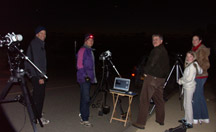
After Comet-set,
our happy crew, including a lucky local and her daughter, who came for
the sunset and got a lot more.
|

The sunset was
nice, suitable for making this over-the-top amp'ed up version in Photoshop.
|
|
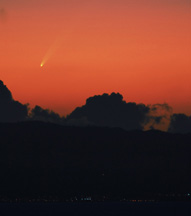
Chris
Kitting got this nice moody shot from the Hayward Hills - 5:46pm PST.
Nikon D200. 400mm on tripod. 1/6 sec at f/6.3 ISO 400. Photoshop: curves,
cropped. Clouds over the SF Bay and San Mateo. |
January 12 - Off Western
Drive
This night, the night before perihelion
and expected to be our last, Jay joined me. Plan "A" was to meet at
the west field house at UCSC, but after 45 minutes of trying, I could not find
an unobstructed horizon in the critical direction, so we both retreated to Western
Drive, this time to the little park at the end of the cul-de-sac and with a
nice view to an adjacent ridge essentially at 0 degrees altitude. We quickly
assembled the neighborhood, who enjoyed the view of the comet while Jay and
I both gathered camcorder footage. Jay used a telephoto lens on the front of
his Canon, and I used the built-in 20x optical zoom, mounting the camcorder
on the approximately polar aligned GM8 mount.
Jan 13 - Perihelion Day!
Weather was once again perfectly
clear and cold and Spaceweather.com had many reports of easy daylight visibility.
I gave it a try from home, at 1pm from my carport I hid the sun behind the neighbor's
trees and found the comet easily in binoculars, and then by just looking up
without the bino's. Amazing! My first daylight comet. I recalled my attempts
to see Comet Ikeya-Seki in 1965 by hiding the sun behind a corner of the gym
at Newton Junior High School, and failing. I estimated the magnitude at m=-5.5,
definitely much brighter than Venus. It is not possible to get a good magnitude
estimate after sunet, as Venus is too high and to much in a dark sky, while
the comet was buried in bright twilight and only a couple of degrees up. Only
by trying to remember what Venus looked like a month ago when it was setting
in similar conditions in the west, could some guess be made. I thought about
driving up to Berkeley to photo the comet setting over the Golden Gate Bridge
- something I've wanted to do for some time. But I also wanted to attend the
Santa Cruz Track Club annual banquet - so I compromised - I drove up to Fremont
Peak hoping the gain in altitude would help make the twilight comet easier to
see now that it was setting sooner, and I calculated it would set over Pacific
Grove/Monterey Peninsula, making a nice shot. When I arrived, I found the campground
gate locked - doh!! I needed to be there to see the comet set on an ocean horizon.
Best alternative was to park in the upper lot and forget about using the telescope,
and instead walk to the radio towers and photograph just using the dimage A2.
I noticed a couple who hiked to the summit and stayed after sunset to see the
comet with binoculars. It was a little less impressive than the previous night
due to the early setting and a layer of haze near the horizon. But I snapped
a few shots (posted soon).
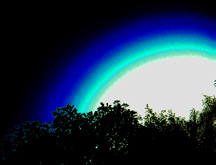
Daylight Comet! 1:05pm.
Dimage A2, overexposed, then severely 'level'ed in Photoshop CS2. The
comet is on the left side of the bloom, just above a protruding patch
of avacado tree leaves. The tail is pointing up and to the left.
|
|
|
|
Jan 14 -
from home. No photos today, but I did find the comet in binoculars
once again. But it was distinctly fainter. I'd estimate m=-4. I tried but failed
to find it by naked eye. The tail was now less linear and instead came from
the head in a wide near-circumference. The following day, Jan 15, I was not
able to find it in binoculars. However, the sky was a bit hazier as well, and
the comet was now south of the sun which made hiding the sun harder to do well.
Jan 19 - Coast Rd.
I thought the show was over... but the jets of dust evaporated off near perihelion
shot northward in a giant splash and graced the evening skies for several days
this week. I missed the opportunity on the 18th but got a nice set of cloud
silhouettes from the turnoff of Hwy 1 and Coast Rd a few miles north of Santa
Cruz.
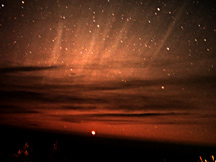
6:47pm. 44sec with
ST2000XCM + 24mm Zuiko lens at f/2.8, on tripod. Venus is setting into
the Pacific, and the comet streamers had to compete with a strong zodiacal
light background. Visible to the naked eye even through the clouds.
These streamers extend over 20 degrees above the horizon, and the head
of the comet was over 21 degrees BELOW the horizon. Tip to tail, this
comet is almost as big now as Comet Hyakutake. It's simply gorgeous!
Dark subtracted and flat fielded, single-shot color RGB processed in
CCDOPS. Photoshop CS2: levels, AstroTools 'make stars smaller', 'space
noise reduction', 'deep space noise reduction'.
|
|
|
|
Jan 20 - Bonny Doon Airfield.
I got together with the Santa Cruz Astronomy Club's monthly observing session,
with my main goal to photograph the comet tail with tall redwoods in the distance
as a foreground, and hopefully some deep sky targeting afterwards. The nucleus
was now way deep into the southern hemisphere in microscopium, and yet the tail
streamers extend across Aquarius and almost into Pegasus. Stem to stearn, the
visible comet now extends almost 60 degrees by my estimate, and growing exponentially
each day. This dramatic increase in side is because the comet was approaching
us towards perihelion, which came on the near side of the sun, and the fantastic
boil-off is headed into our direction. Interesting exercise - try and match
up the star patterns last night to tonight. Not easy, because your expectation
is that the tail is moving roughly like a planet, migrating slowly eastward.
In fact, the tail has moved almost one entire wide-angle field of
view upward in a single day! The treeline horizon in tonight's
picture is approximately the top of the previous night's frame. The pair of
bright stars in the Jan 19 photo at extreme upper left corner, are down almost
at the treeline (one star has the hooked streamer going through it) in the picture
at lower right. At this rate, the tail streamers will easly outpace the eastward
moving sun and will stay in our sky for good - except that the waxing moon will
ruin the view from now on. I also did some deep sky object photography after
the comet show was over - here's a link
to that page.
| |
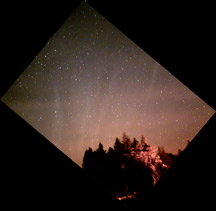
6:59pm.
1 minute guided. sRGB single shot color processed in CCDOPS5. Photoshop
CS2: levels, color balance, rotate canvas, cosmetics on undersampled stars,
AstroTools 'space noise reduction'. Horizontal light cirrus contrast with
the blue dusty comet tail streamers. 4% cresent moon 3 degrees up, behind
those trees, and lightened the sky significantly |
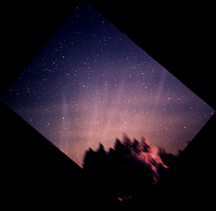
7:04pm.
3 minute guided. sRGB single shot color processed in CCDOPS5. Photoshop
CS2: color balance, rotate canvas, cosmetics on undersampled stars, levels,
AstroTools 'space noise reduction', rebalance color, brightness, conrast,
hue, saturation. 4% cresent moon 2 degrees up, behind trees. |
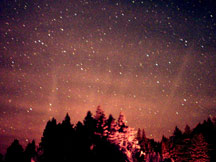
7:25pm, just after
moonset. 44 sec unguided on tripod. sRGB single shot color in CCDOPS5.
Photoshop CS2: color balance, levels, AstroTools 'space noise reduction',
more color balance, brightness, contrast
|


